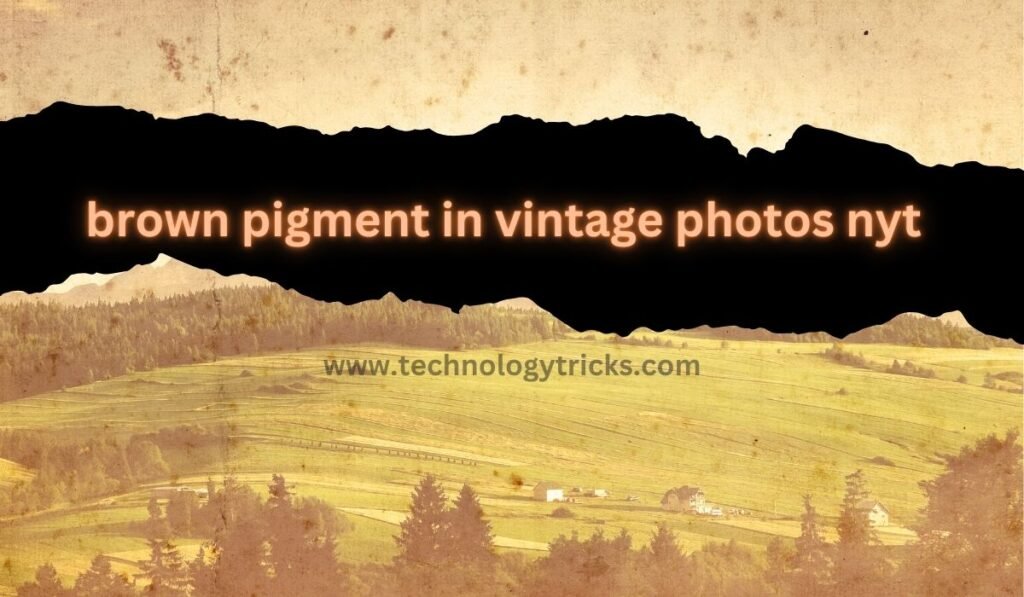Brown pigment in vintage photos nyt The magic of vintage photography lies in the fact that its color may have been of a distinct brownish hue to give old images their characteristic feel. The brown pigment that adorns most vintage photographs is more than just a color; it is evocative of materials, techniques, and the historical moment in which the photographs were created.
Understanding the causes this brown pigment crops up in vintage photos, and how this reflects on the aspect of preservation of such images, is important to historians, photographers, and enthusiasts alike. This blog post looks at where the brown pigment in vintage photographs comes from, what this means in terms of the history of photography, and some best practices for preserving these dear artifacts.
1. What Causes the Brown Pigment to Appear in Vintage Photos?
The brown caused by the old photographs is primarily due to the photographic processing and materials used for photographs in the 19th and early 20th centuries. This part discusses the major contributing factors for the brownish tint of the old photographs.
1.1 Early Photography and the Role of Silver Nitrate
One of the oldest forms of photography, called the daguerreotype, uses silver nitrate as part of the developing process. With this chemical being sensitive to light, early photographers could capture images on metal plates using silver nitrate. However, over time, chemical reactions between silver nitrate and light exposure led to the development of a brownish tint in the images.
- Statistics: In the 1840’s as many as 90% of photographs made in the United States were daguerreotypes and all had this brownish tint because the image was made with made with silver nitrate.
1.2 Sepia Toning
Sepia toning is another major contributor to the brown pigment in classic photos. Sepia toning was invented in the 1880s to improve the stability of photographic prints. It involves the replacement of metallic silver in a photograph with a compound of silver sulfide, which not only enables the photo to appear brown in tint but also makes it more structurally stable enough for archiving.
- Data Point: Sepia-toned photographs are believed to have at least a 50 percent more resistance to fading than the normal black-and-white photographs. This is the reason why this technique was popular during the late 19th and early 20th century.
1.3 The Impact of Aging and Environmental Factors
The old photographs undergo various chemical changes due to the light they are exposed to, together with air and humidity. These could be the reasons for the oxidation of the silver particles of the photograph and thereby change from black-and-white to brown. Moreover, paper and other ingredients of early photography were seen with impurities that totally helped in discoloration.
The magic of vintage photography lies in the fact that its color may have been of a distinct brownish hue to give old images their characteristic feel. The brown pigment that adorns most vintage photographs is more than just a color; it is evocative of materials, techniques, and the brown pigment in vintage photos nyt historical moment in which the photographs were created.
Table 1: Common Causes of Brown Pigment in Vintage Photos
| Cause | Description | Effect on Photo Color |
|---|---|---|
| Silver Nitrate Reaction | Light-sensitive silver nitrate darkens over time, leading to a brownish tint in the image. | Brownish Hue |
| Sepia Toning | Replacing silver with silver sulfide for enhanced durability, resulting in a brown color. | Sepia/Brown Tint |
| Environmental Oxidation | Exposure to air and humidity oxidizes silver particles, causing discoloration. | Gradual Browning |
| Paper and Material Aging | Impurities in paper and materials contribute to a natural shift in color over time. | Yellow to Brown Hue |
2. History of Brown Pigmentation in Photography
The brown pigment within the archival photographs is not only of a chemical origin but also of historical significance. The research here explores how the brown pigment in vintage photos nyt brown color acts as something indicative of the history not only of photographic technology but also of the relationship that this technology enjoyed with society.
2.1 Daguerreotype Period: The Infancy of Photography
1839 is the first year of practical photography developed by Louis Daguerre, named daguerreotype. The images were in the peculiar brown shade characteristic of this first mass form of photographic documentation. The brown tinge was a technical coincidence and signatory for this pioneer epoch of photography.
- Historical Fact: More than three million daguerreotypes had been done by 1850 in the United States, a fact that made it one of the popular portrait forms.
2.2 The Aesthetic Appeal of Sepia in the Victorian Era
Sepia photography became very fashionable during the Victorian era. It was thought brown pigment in vintage photos nyt that warm brown tones were far more attractive than the harsh contrasts arising from black-and-white imagery. This dictated the general usage of sepia toning, which helped in preserving images and made those images more artistic.
- Cultural Insight: The sepia tone became synonymous with sentimentality and nostalgia, oft used in portraits and family albums to evoke a sense of warmth and timelessness.
2.3 The Transition to Modern Photography
With the development of photographic technologies, materials and photo brown pigment in vintage photos nyt production chemicals also began to change. By the late 19th century, the introduction of gelatin silver prints allowed for very detailed and contrastive images to be reproduced and, in effect, slowly dwindled the presence of brown-colored photographs. However, the role of brown pigment in early photography is impressively continued through contemporary photographic art and preservative practices.
- Note: Sepia-toned photographs were superseded for the most brown pigment in vintage photos nyt part by gelatin silver prints early in the 20th century but are still a staple of fine-art photography today.
3. Preservation of Vintage Photos with Brown Pigment
One essential factor in the preservation of vintage photos, especially brown pigment in vintage photos nyt those with a brown pigment finish, is to maintain proper control over the environmental conditions and to handle them appropriately. This chapter gives in detail the best practices that shall ensure the security of these priceless items.
3.1. Light Exposure Risk, Room Temperature, and Relative Humidity Control
The three most critical elements associated with retaining vintage photographs are those of light, temperature, and humidity in controlling the aging process. These factors accelerate the deterioration of the image and deepen the brown pigment.
- Light Exposure: Sunlight will fade the photographs and increase oxidation. Store the photos in a dark, cool environment.
- Temperature and Humidity: These changes in temperature brown pigment in vintage photos nyt and humidity can affect the materials comprising the photograph, leading to expansions and contractions that can crack or discolor it. The surrounding environment should be stable at an optimal temperature of 65°F to 70°F and relative humidity of approximately 30% to 40%.
3.2 Good Handling and Storage Practices
They must also be handled with care not to cause further brown pigment in vintage photos nyt damage. One must use clean and dry hands or cotton gloves to avoid carrying oils and dirt from other places to the photos.
- Storage Materials: One should use photo albums, envelopes, and boxes that are acid-free and of archival quality for the storage of the photos. The Photo-safe materials prevent the acids that are in standard paper products from further destroying the photos.
- Vertical storage: Keep your pictures upright, never one on top of another because they will bow and crease.
Table 2: Recommended Conditions for Preserving Vintage Photos
| Preservation Factor | Recommended Condition |
|---|---|
| Light Exposure | Store in dark, cool environments, away from sunlight. |
| Temperature | Maintain between 65°F and 70°F |
| Humidity | Keep relative humidity around 30-40% |
| Handling | Use cotton gloves, handle by the edges |
| Storage Materials | Acid-free, archival-quality albums, envelopes, boxes |
| Storage Position | Store vertically to prevent creasing |
4. Artistic Implication of brown pigment in vintage photos nyt in Photography
Photography
The brown pigment in vintage photos acts more than a technical brown pigment in vintage photos nyt artifact; it significantly contributes to the artistic interpretation of photography. This section is dedicated to explaining how the brown tint gives more visual and emotional effect to photographs.
4.1 The Aesthetic Value of Sepia and Brown Tones
Whether it is sepia or brown, it is said to connote warmth, nostalgia, and timelessness in general. Photographers and artists have used these for so many years in their work because it is an easy signifier to denote a particular feel related to history or emotional depth.
Sepia toning is an artistic use by many photographers today in order to anchor their work to a feel intended for the past.
The brown tint of the photographs would alter the perceptions brown pigment in vintage photos nyt and attachment of viewers towards the image. Often, the warmth that is elicited through the shades of brown stirs a sense of views to nostalgia and appeal to the past, which makes a photo more relatable and touching.
- Psychological Effect: It has been documented by researchers that often, viewers perceive the tones of sepia in relation to memories and historical moments, developing their emotional appeal to the photo.
4.3 Legacy of brown pigment in vintage photos nyt to Modern Photography and Visual Culture
The legacy of sepia has continued to influence modern photography. Many photographers and digital artists use sepia filters and brown tones in creating vintage aesthetics, sometimes fusing old and new techniques to come up with a timeless picture.
- Cultural Influence: The recent popularity of vintage effects brown pigment in vintage photos nyt photography on platforms like Instagram shows that brown tone is not a phase that has passed in visual culture.
5. Common Queries About Brown Pigment in Vintage Photos
Once the brown pigment in vintage photos is understood, there’s much to question. The section covers the frequently asked questions with an eye on clearing doubts and providing more information.
5.1 Why Do Vintage Photos Turn Brown Over Time?
The brown tint in pictures is caused by the chemical reactions brown pigment in vintage photos nyt of early photographic processes’ materials. It is also due to silver nitrate, sepia toning, and other elements in the environment, like light and humidity, that make the color change gradually.
5.2 Is the Brown Tint in Photos Harmful to the Image?
This brown tinting itself is not harmful; however it may reflect more serious chemical changes underlying its development that can be more harmful in further degrading the image. Proper preservation techniques are vital to maintaining the quality of an image.
5.3 Is It Possible to Reverse the Brown Pigment in Older Photographs?
The extent to which the brown pigment of a very old photo can be completely reversed is to a large extent not so substantial. However, digital restoration techniques improve the image by color and contrast correction, rendering a better view of the original photo.
5.4 How Can I Preserve My Vintage Photos?
Control the exposure of your vintage photos to light, brown pigment in vintage photos nyt temperature, and humidity. The storage of photos has to be on archival quality materials and handled properly to minimize further damages.
5.5 What Artistic Function Does Brown Pigmentation Play in Photography?
The brown pigment of photography gives a more aesthetic and emotional feeling to the picture, creating a nostalgic effect and giving connotations of something historical. Therefore, this kind of print is still popular today among some photographers who want to give a picture brown pigment in vintage photos nyt either a timeless look or a vintage one.
5.6 Are There Modern Alternatives to Achieve a Similar Brown Tint in Photos?
Of course, modern photographers can get a similar brown tint by using digital filters, sepia toning, or some other way of post-processing. This is where artistic expression can be enabled without compromise on quality.
6. Conclusion:
The brown pigment in vintage photos speaks volumes to brown pigment in vintage photos nyt photography history and testifies both to technical limitations and to artistic choices of that time. The development of this brown hue, its causes, and significances stimulate appreciation for vintage photos and afford an understanding of the way we are supposed to treat this valuable piece of history. Whether working at the levels of pure nostalgia or technical artifact, that brown pigment in vintage photography continues to influence, successfully bridging both the past and the present in a timeless visual dialogue.
More important than that, though, we are saving our cultural heritage and enabling future generations to experience the unique aesthetic beauty and emotional resonance that has come to typify vintage photography. With proper methods of preservation and considering the historic context, the integrity of such images is preserved to further celebrate their resilient legacy.

